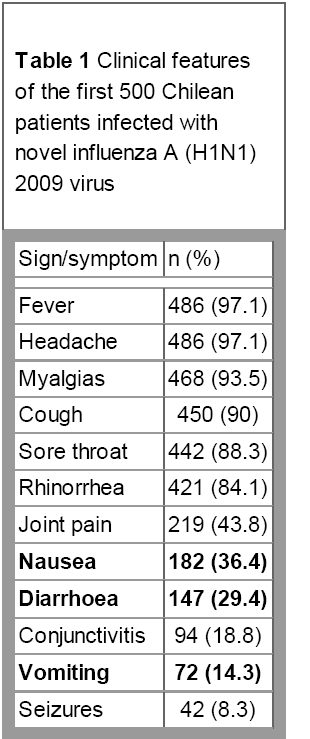 The incidence of gastric events in normal seasonal flu is very low, almost never. The H1N1 swine Flu virus has differentiated itself from the seasonal flu not only in its speed of migration around the world, but also in the development of gut related events.
The incidence of gastric events in normal seasonal flu is very low, almost never. The H1N1 swine Flu virus has differentiated itself from the seasonal flu not only in its speed of migration around the world, but also in the development of gut related events.
A new article in the International journal GUT [1] explains how a well set up investigational group based in Chile – a country well exposed to the virus, followed the first 500 confirmed patients who were infected with the influenza A (H1N1) 2009 virus back in May 2009.
 The primary symptom was a febrile respiratory infection that varied in severity from a mild self limiting event to severe illness.
The primary symptom was a febrile respiratory infection that varied in severity from a mild self limiting event to severe illness.
The second area of symptom dominance is in the gut – again there were significant variations in the severity and duration but worryingly some patients developed severe illness including enterocolitis. Typically this was preceded by vomiting/or diarrhoea as the main symptom in the first 12 hours.
Gastrointestinal symptoms were frequently found among Chilean patients with confirmed influenza A (H1N1) 2009 virus infection including: 72 patients with vomiting (14.3%), 147 patients with diarrhoea (29.4%) and 182 patients (36.4%) with nausea
A similar pattern was also found in the results from a North American study where 25% of confirmed H1N1 infected people had gastrointestinal problems.[2]
The pathophysiology of these symptoms is not yet clear, but novel influenza A (H1N1) 2009 virus could be harboured in the digestive tract or a systemic inflammatory response could affect the circulatory system and/or the central nervous system, generating nausea, vomiting or diarrhoea.
The Gut is the primary site of innate immune cells and will on a typical day process more immunological information than the rest of the body does in a lifetime. The mucosal immune support programme offers practical suggestions and evidence based strategies to improve this tissues competence in resisting and managing viral infection.






1 Comment. Leave new
Very interesting contribution on the subject.
I have noticed a large percentage of my own patients who have had H1N1 confirmed infections have recovered rapidly with probiotics and high vit C supplementation, (5-10 grams daily). They also don’t seem to suffer from protracted post viral fatigue which in many lasts for weeks.
Several patients receiving their jabs have gone on to contract other viral infections, presumably due to reduced immune function to other viral/microbial spread.
Many patients report being vaccinated with clear signs of existing URT infection, which is not supposed to happen…. but does!
Perhaps also older patients who are in the ‘at risk’ group should be advised to stimulate HCL production with supplementation and/or cider vinegar which has an anecdotal history suggesting improved stomach secretion of acids. Optimal levels of HCL acts as a natural buffer against pathogens, and the reduced output of patients with age-related or medication-linked achlorhydria probably contributes to their likelihood of both contracting this virus, as well as making a rapid recovery from it also.